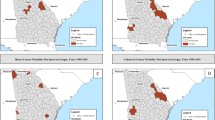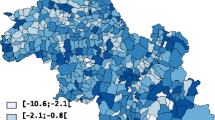Abstract
Since an overarching goal of Healthy People 2010 was to eliminate health disparities, we determined temporal trends in socioeconomic disparities in five breast-cancer indicators (in situ, stage I, lymph-node positive, and locally advanced breast-cancer incidence, and breast-cancer mortality) by county socioeconomic deprivation using 1988–2005 population-based breast-cancer data. Using 1988–2005 data from women aged 40 and older from 200 counties in the Surveillance, Epidemiology, and End Results program, we examined trends in temporal disparities in the five breast-cancer indicators across quartiles of county socioeconomic deprivation. County-level trends were summarized using the estimated annual percentage change. Observed county rates were smoothed using Bayesian hierarchical spatiotemporal methods to calculate measures of absolute and relative disparity (using absolute and relative concentration indices) and their changes over time. Large increases in in situ breast cancer rates since 1988 were observed for each of the deprivation quartiles. Absolute and relative disparity both increased over time, suggesting increasing disparities across levels of county deprivation. Absolute and relative concentration indices were near zero for the other four breast-cancer indicators, suggesting no disparities among the four quartiles of county deprivation during 1988–2005. Efforts to target counties aimed at increasing breast-cancer screening based on their level of deprivation will not likely be beneficial.





Similar content being viewed by others
References
Breen N, Wagener DK, Brown ML, Davis WW, Ballard-Barbash R (2001) Progress in cancer screening over a decade: results of cancer screening from the 1987, 1992, and 1998 National Health Interview Surveys. J Natl Cancer Inst 93:1704–1713
Swan J, Breen N, Coates RJ, Rimer BK, Lee NC (2003) Progress in cancer screening practices in the United States: results from the 2000 National Health Interview Survey. Cancer 97:1528–1540
Schootman M, Jeffe DB, Baker EA, Walker MS (2006) Effect of area poverty rate on cancer screening across US communities. J Epidemiol Community Health 60:202–207
Robert SA, Strombom I, Trentham-Dietz A, Hampton JM, McElroy JA, Newcomb PA, Remington PL (2004) Socioeconomic risk factors for breast cancer: distinguishing individual- and community-level effects. Epidemiology 15:442–450
Vona-Davis L, Rose DP (2009) The influence of socioeconomic disparities on breast cancer tumor biology and prognosis: a review. J Womens Health 18:883–893
Schootman M, Jeffe D, Lian M, Gillanders WE, Aft R (2009) The role of poverty rate and racial distribution in the geographic clustering of breast cancer survival among older women: a geographic and multilevel analysis. Am J Epidemiol 169:554–561
Sabatino S, Coates RJP, Uhler RJMA, Breen NP, Tangka FP, Shaw KMMS (2008) Disparities in mammography use among US women aged 40–64 years, by race, ethnicity, income, and health insurance status, 1993 and 2005. Med Care 46:692–700
Schootman M, Jeffe DB, Reschke AH, Aft R (2003) Disparities related to socioeconomic status and access to medical care remain in the United States among women who never had a mammogram. Cancer Causes Control 14:419–425
U.S. Department of Health and Human Services: Healthy People 2010. Conference edition. Washington, D.C.: U.S. Government Printing Office
National Cancer Institute (2006) The NCI strategic plan for leading the nation to eliminate the suffering and death due to cancer. National Cancer Institute, US Department of Health and Human Services, Washington DC
Fleming ID, Cooper JS, Henson DE, Hutter RVP, Kennedy BJ, Murphy GP, Sullivan BO, Sobin LH, Yarbro JW (1997) AJCC cancer staging manual, 5th edn. Lippincott-Raven, Philadelphia
Tabar L, Duffy SW, Yen MF, Warwick J, Vitak B, Chen HH, Smith RA (2002) All-cause mortality among breast cancer patients in a screening trial: support for breast cancer mortality as an end point. J Med Screen 9:159–162
Singh G (2003) Area deprivation and widening inequalities in US mortality, 1969–1998. Am J Public Health 93:1137–1143
Diez-Roux AV, Kiefe CI, Jacobs DR Jr, Haan M, Jackson SA, Nieto FJ, Paton CC, Schulz R, Roux AV (2001) Area characteristics and individual-level socioeconomic position indicators in three population-based epidemiologic studies. Ann Epidemiol 11:395–405
Messer LC, Laraia BA, Kaufman JS, Eyster J, Holzman C, Culhane J, Elo I, Burke JG, O’Campo P (2006) The development of a standardized neighborhood deprivation index. J Urban Health 83:1041–1062
Krieger N, Chen J, Waterman P, Soobader M, Subramanian S, Carson R (2002) Geocoding and monitoring of socioeconomic inequalities in mortality and cancer incidence: does the choice of area-based measure and geographic level matter? Am J Epidemiol 156:471–482
Knorr-Held L (2000) Bayesian modelling of inseparable space-time variation in disease risk. Stat Med 19:2555–2567
Besag J, York J, Mollie A (1991) Bayesian image restoration with two applications in spatial statistics. Ann Inst Stat Math 43:1–59
US Geological Survey. Adjacency for WinBUGS tool. http://www.umesc.usgs.gov/management/dss/adjacency_tool.html Last accessed 12 Aug 2009
Spiegelhalter D, Best N, Carlin B, van der Linde A (2002) Bayesian measures of model complexity and fit (with discussion). J R Stat Soc Ser B Methodol 64:583–616
Kim H, Fay M, Feuer E, Midthune D (2000) Permutation tests for joinpoint regression with applications to cancer rates. Stat Med 19:335–351
Statistical research and applications branch, National Cancer Institute (2008) Joinpoint regression program. Version 3.2 Bethesda, MD
Kim H, Fay M, Yu B, Barrett M, Feuer E (2004) Comparability of segmented line regression models. Biometrics 60:1005–1014
Harper S, Lynch J (2006) Methods for measuring cancer disparities: A review using data relevant to Healthy People 2010 cancer-related objectives. In: Institute NC (ed) NCI Cancer Surveillance Monograph Series no 6. Washington, DC
Houweling T, Kunst A, Huisman M, Mackenbach J (2007) Using relative and absolute measures for monitoring health inequalities: experiences from cross-national analyses on maternal and child health. Int J Equity Health 6:15
Harper S, Lynch J (2006) Measuring health inequalities. In: Oakes J, Kaufman J (eds) Methods in social epidemiology. Jossey-Bass, San Francisco, pp 134–168
National Cancer Institute, Surveillance Research Program. Health Disparities Calculator Software http://seer.cancer.gov/hdcalc/. Last accessed 20 Nov 2009
Edwards BK, Brown ML, Wingo PA, Howe HL, Ward E, Ries LA, Schrag D, Jamison PM, Jemal A, Wu XC (2005) Annual report to the nation on the status of cancer, 1975–2002, featuring population-based trends in cancer treatment. J Natl Cancer Inst 97:1407–1427
American Cancer Society (2007) Breast cancer facts and figures 2007–2008. American Cancer Society, Atlanta
Li CI, Daling JR, Malone KE (2005) Age-specific incidence rates of in situ breast carcinomas by histologic type, 1980 to 2001. Cancer Epidemiol Biomarkers Prev 14:1008–1011
Tsikitis VL, Chung MA (2006) Biology of ductal carcinoma in situ classification based on biologic potential. Am J Clinical Oncol 29:305–310
Harper S, Lynch J, Meersman SC, Breen N, Davis WW, Reichman MC (2009) Trends in area-socioeconomic and race-ethnic disparities in breast cancer incidence, stage at diagnosis, screening, mortality, and survival among women ages 50 years and over (1987–2005). Cancer Epidemiol Biomarkers Prev 18:121–131
Harper S, Lynch J, Meersman SC, Breen N, Davis WW, Reichman ME (2008) An overview of methods for monitoring social disparities in cancer with an example using trends in lung cancer incidence by area-socioeconomic position and race-ethnicity, 1992–2004. Am J Epidemiol 167:889–899
Leitch AM, Dodd GD, Costanza M, Linver M, Pressman P, McGinnis L, Smith RA (1997) American Cancer Society Guidelines for the early detection of breast cancer: update 1997. CA Cancer J Clin 47:150–153
U.S. Preventive Services Task Force. Agency for Healthcare Research and Quality. Screening for breast cancer, topic page, Nov 2009. [http://www.ahrq.gov/clinic/uspstf/uspsbrca.htm]
Acknowledgments
This research was supported in part by grants from the National Cancer Institute (CA109675, CA91842). We thank the Alvin J. Siteman Cancer Center at Barnes-Jewish Hospital and Washington University School of Medicine in St. Louis, Missouri, for allowing the use of the Health Behavior and Outreach Core.
Author information
Authors and Affiliations
Corresponding author
Rights and permissions
About this article
Cite this article
Schootman, M., Lian, M., Deshpande, A.D. et al. Temporal trends in area socioeconomic disparities in breast-cancer incidence and mortality, 1988–2005. Breast Cancer Res Treat 122, 533–543 (2010). https://doi.org/10.1007/s10549-009-0729-y
Received:
Accepted:
Published:
Issue Date:
DOI: https://doi.org/10.1007/s10549-009-0729-y




